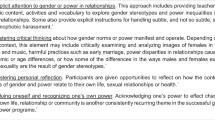Abstract
A peer leader-based intervention using social media can be an effective means to encourage Peruvian gay men to test for HIV. The objective was to explore the feasibility of recruiting and training leaders to deliver a peer intervention via Facebook to promote HIV testing. Training consisted of three sessions focused on HIV epidemiology, consequences of stigma associated with HIV, and ways to use Facebook. We performed pre- and post-training evaluations to assess HIV knowledge and comfort using Facebook. We trained 34 peer leaders. At baseline, the majority of peer leaders were already qualified and knowledgeable about HIV prevention and use of social media. We found a significant increase in proportion of peer leaders who were comfortable using social media to discuss about sexual partners and about STIs. It is feasible to recruit peer leaders who are qualified to conduct a social media based HIV prevention intervention in Peru.
Resumen
Una intervención de líderes pares en una red social puede ser un medio efectivo para promover la prueba del VIH en hombres gays Peruanos. El objetivo fue explorar la factibilidad de reclutar y entrenar a líderes para ejecutar una intervención en Facebook para promover la prueba del VIH. El entrenamiento consistió en tres sesiones: Epidemiología del VIH, consecuencias del estigma asociado al VIH, y uso de Facebook para comunicarse. Entrenamos a 34 participantes. Antes del entrenamiento, la mayoría de líderes ya conocía acerca de prevención del VIH y estaba calificado para el uso de redes sociales. Encontramos un incremento significativo en la comodidad para usar Facebook para discutir acerca de parejas sexuales y de infecciones de transmisión sexual. Es factible reclutar pares calificados para conducir una intervención en Facebook para prevenir el VIH en gays Peruanos.
Similar content being viewed by others
References
Duan Y, Zhang H, Wang J, Wei S, Yu F, She M. Community-based peer intervention to reduce HIV risk among men who have sex with men in Sichuan province, China. AIDS Educ Prev. 2013;25(1):38–48.
Medley A, Kennedy C, O’Reilly K, Sweat M. Effectiveness of peer education interventions for HIV prevention in developing countries: a systematic review and meta-analysis. AIDS Educ Prev. 2009;21(3):181–206.
St Lawrence JS, Brasfield TL, Diaz YE, Jefferson KW, Reynolds MT, Leonard MO. Three-year follow-up of an HIV risk-reduction intervention that used popular peers. Am J Public Health. 1994;84(12):2027–8.
Young SD, Konda K, Caceres C, Galea J, Sung-Jae L, Salazar X, et al. Effect of a community popular opinion leader HIV/STI intervention on stigma in urban, coastal Peru. AIDS Behav. 2011;15(5):930–7.
Zhang H, Zhu J, Wu Z, Pang L, Zhang L, Li T, et al. Intervention trial on HIV/AIDS among men who have sex with men based on venues and peer network. Zhonghua Yu Fang Yi Xue Za Zhi. 2009;43(11):970–6.
Maulsby C, Millett G, Lindsey K, Kelley R, Johnson K, Montoya D, et al. A systematic review of HIV interventions for black men who have sex with men (MSM). BMC Public Health. 2013;13:625.
Hightow-Weidman LB, Smith JC, Valera E, Matthews DD, Lyons P. Keeping them in “STYLE”: finding, linking, and retaining young HIV-positive black and Latino men who have sex with men in care. AIDS Patient Care STDS. 2011;25(1):37–45.
NIMH Collaborative HIV/STD Prevention Trial Group. The community popular opinion leader HIV prevention programme conceptual basis and intervention procedures. AIDS. 2007;21(Suppl 2):S59–68.
Mellanby AR, Newcombe RG, Rees J, Tripp JH. A comparative study of peer-led and adult-led school sex education. Health Educ Res. 2001;16(4):481–92.
Maiorana A, Kegeles S, Fernandez P, Salazar X, Cáceres C, Sandoval C, et al. Implementation and evaluation of an HIV/STD intervention in Peru. Eval Program Plann. 2007;30(1):82–93.
Peru Country Progress Report UNAIDS [Internet]. 2011. http://www.unaids.org/en/dataanalysis/knowyourresponse/countryprogressreports/2012countries/ce_PE_Narrative_Report.pdf. Accessed 23 Jan 2015.
UNAIDS Report on the global AIDS epidemic 2012 [Internet]. 2012. http://www.unaids.org/en/resources/documents/2012/20121120_UNAIDS_Global_Report_2012. Accessed 23 Jan 2015.
Blas MM, Alva IE, Carcamo CP, Cabello R, Goodreau SM, Kimball AM, et al. Effect of an online video-based intervention to increase HIV testing in men who have sex with men in Peru. PLoS One. 2010;5(5):e10448.
Blas MM, Alva IE, Cabello R, Garcia PJ, Carcamo C, Redmon M, et al. Internet as a tool to access high-risk men who have sex with men from a resource-constrained setting: a study from Peru. Sex Transm Infect. 2007;83(7):567–70.
Blas MM, Menacho LA, Alva IE, Cabello R, Orellana ER. Motivating men who have sex with men to get tested for HIV through the Internet and mobile phones: a qualitative study. PLoS One. 2013;8(1):e54012.
Curioso WH, Kurth AE. Access, use and perceptions regarding internet, cell phones and PDAs as a means for health promotion for people living with HIV in Peru. BMC Med Inform Decis Mak. 2007;7:24.
Curioso WH, Blas MM, Nodell B, Alva IE, Kurth AE. Opportunities for providing web-based interventions to prevent sexually transmitted infections in Peru. PLoS Med. 2007;4(2):e11.
Facebook statistics [Internet]. 2013]. http://en.wikipedia.org/wiki/Facebook_statistics. Accessed 18 Apr 2013.
Jaganath D, Gill HK, Cohen AC, Young SD. Harnessing Online Peer Education (HOPE): integrating C-POL and social media to train peer leaders in HIV prevention. AIDS Care. 2012;24(5):593–600.
Young SD. Analysis of online social networking peer health educators. Stud Health Technol Inform. 2012;181:253–9.
Young SD, Jaganath D. Online social networking for HIV education and prevention: a mixed-methods analysis. Sex Transm Dis. 2013;40(2):162–7.
Young SD, Cumberland WG, Lee S-J, Jaganath D, Szekeres G, Coates T. Social networking technologies as an emerging tool for HIV prevention: a cluster randomized trial. Ann Intern Med. 2013;159(5):318–24.
Young SD, Harrell L, Jaganath D, Cohen AC, Shoptaw S. Feasibility of recruiting peer educators for an online social networking-based health intervention. Health Educ J. 2013;72(3):276–82.
Author information
Authors and Affiliations
Corresponding author
Rights and permissions
About this article
Cite this article
Menacho, L.A., Galea, J.T. & Young, S.D. Feasibility of Recruiting Peer Educators to Promote HIV Testing Using Facebook Among Men Who have Sex with Men in Peru. AIDS Behav 19 (Suppl 2), 123–129 (2015). https://doi.org/10.1007/s10461-014-0987-5
Published:
Issue Date:
DOI: https://doi.org/10.1007/s10461-014-0987-5




